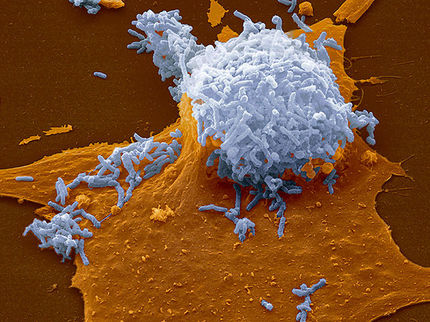Novel Inhibitors of MurA, an Antibacterial Target Enzyme
Advertisement
The occurrence of infectious diseases has been increased dramatically during the past 20 years, due to antibiotic resistance, global warming and globalization (intense travelling). Primarily, the resistance of bacteria against existing antibiotics, caused particularly by adding antibiotics in animal feeding, urgently demand new approaches in antibiotics research to fight „multi-drug resistant organisms“ (MDRO´s). Due to the fact that is has mistakenly been thought over the past decades that enough effective antibiotics are on the market, and also under economical considerations that by the development of new antibiotics the profit to be expected would anyway be much lower comparing to the development of drugs in other therapeutic areas, antibiotics research has widely been neglected by the pharmaceutical industry over long time. Consequently, in the past 40years only three new classes of antibiotic compounds were discovered: cyclic lipopeptides, glycylcyclines, and oxazolidinones.
The most effective antibiotics address targets connecting with the formation of the bacterial cell wall, such as beta-lactams and glycopeptides, because the biosynthetic pathways involved do not occur in humans. One group of these antibacterial targets is MurA, which catalyzes the early cytoplasmic step of the cell wall biosynthesis. This target has not thoroughly been examined so far, but it has already successfully been addressed by the broad spectrum antibiotic fosfomycin, which covalently attaches to the thiol group of an MurA enzyme cysteine and thus irreversibly inhibits the enzymatic function. However, resistance against fosfomycin takes place very easily by genetic mutation of the enzyme, exchanging the thiol group of cystein against other functional groups. These recover the activity of the enzyme and can not be blocked by fosfomycin any more. The aim of a joint research project, which is performed by Endotherm GmbH together with Prof. Dr. Ch. Klein from the Universität Heidelberg, is the development of new MurA inhibitors, acting in another mode. Particularly, two basic approaches are followed for rational drug discovery: The first one is to mimic a phosphoenol-pyruvate, which in turn is one of the natural substrates of MurA to be used in the first biosynthesis step of cell wall formation. Alternatively, providing a transition state analogue of the natural MurA-substrate-complex, consisting of UNAG (UDP-N-acetylglucosamine) derivatives, may lead to the inhibition of the enzyme. By contrast to fosfomycin, resistance is likely not to be expected by this mode of action.
Following the principle of rational drug design, Endotherm contributes by means of its outstanding experience in medicinal chemistry, including the design and synthesis of focused target-based compound libraries, the group from Prof. Ch. Klein provides expertise concerning the expression of the enzyme and biochemical assays to evaluate Endotherm ´s compounds regarding their MurA inhibiotory properties.
This strategy has already been proven as successful. A significant number of MurA inhibitors have been found, which now subsequently have to be optimized by chemical modification to also exhibit the desired antibiotic activity.


















































